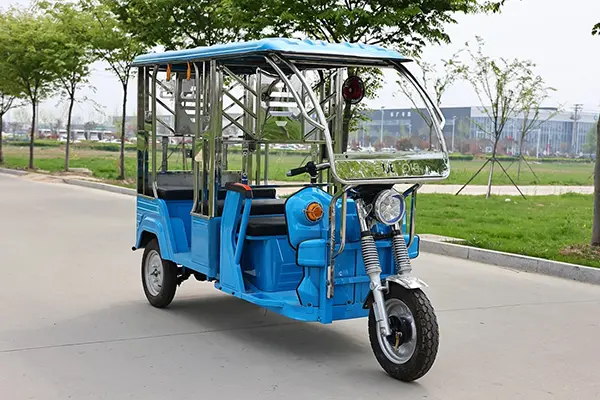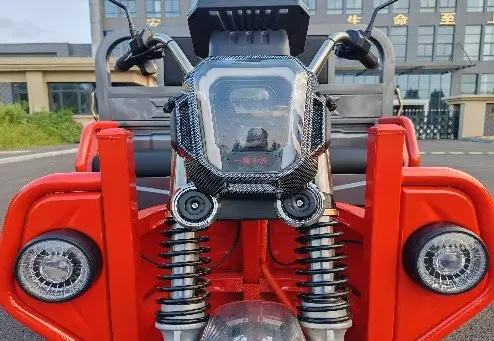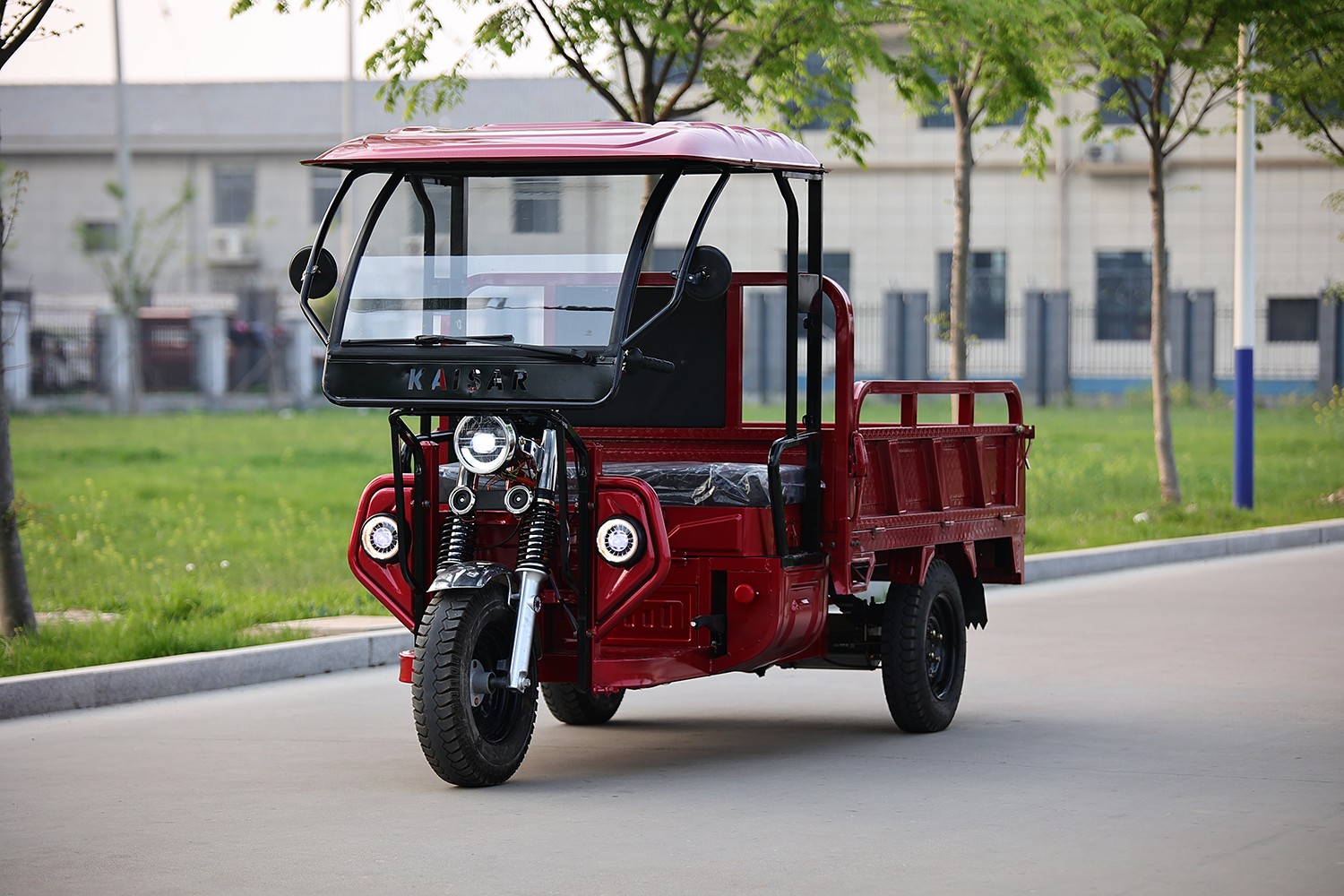Electric tricycles, often called e-trikes, are rapidly gaining popularity not just for personal use but as powerful tools for businesses worldwide. Combining the stability of three wheels with the efficiency of an electric motor, these vehicles offer unique advantages for cargo transport, passenger services, and specialized logistics. If you’re a business owner like Mark Thompson, looking for reliable and cost-effective fleet solutions, understanding the world of electric tricycles is crucial. This guide explores everything from the basic mechanics of an electric trike to the key factors you should consider when sourcing them for your operations, ensuring you make an informed decision that boosts your bottom line. Read on to discover why an e-trike might be the perfect fit for your needs.
Understanding the Buzz: What Exactly is an Electric Tricycle (E-Trike)?
At its core, an electric tricycle or e-trike is a three-wheeled vehicle equipped with an electric motor to assist the rider. Think of it as a standard tricycle enhanced with electric power. Unlike a traditional bike or tricycle that relies solely on pedal power, an electric trike gives you a boost, making it easier to cover longer distances, climb hills, or carry heavier loads. The electric system typically includes a battery, a motor (often a hub motor integrated into one of the wheels or sometimes a mid-drive motor near the pedals), and a controller to manage the power delivery.
Most electric tricycles offer two main modes of operation: pedal assist (PAS) and throttle. With pedal assist, the motor engages automatically as you pedal, providing a level of assistance you can usually adjust (different pas levels). The harder you pedal, the more help you get, making the ride feel very natural, like riding a regular bike but with much less effort. The throttle mode, on the other hand, allows you to engage the motor independently of pedaling, often via a twist grip or thumb lever, turning your trike into something closer to a small scooter, perfect for when you need a break from pedaling or require instant speed.
The unique design of having three wheels (either two in the rear or two front wheels) provides inherent stability compared to a two-wheeled electric bike (e-bike). This stability is a major draw for many users, including seniors seeking better mobility, individuals with balance concerns, and crucially for businesses, those needing to transport goods or passengers safely. The electric power simply makes this stable platform even more versatile and practical for a wider range of applications and terrain. An electric trike isn’t just a novelty; it’s a functional, efficient, and accessible form of transportation.

Why Choose Three Wheels Over Two for Your Business Needs?
The most significant advantage of an electric trike over a standard electric bike is stability. The three-wheel configuration creates a stable platform that doesn’t require the rider to balance, especially at lower speeds or when stopped. This is invaluable in commercial settings. For delivery services, it means riders can easily stop and start without worrying about tipping over, even with a heavy load in the cargo area or basket. For passenger transport, it provides a secure and comfortable ride experience, increasing customer confidence. This inherent stability reduces the learning curve and potential for accidents, making it accessible to a broader range of employees.
Beyond stability, the design of an electric tricycle naturally accommodates larger loads. Whether it’s a dedicated cargo box on an Electric cargo tricycle HJ20 or seating for multiple passengers on an EV5 Electric passenger tricycle, the three wheels provide the necessary support. The frame can be built stronger and larger without compromising balance as much as it would on a two-wheeled bike. This allows businesses to move more goods per trip or carry more passengers, directly improving operational efficiency and profitability. The electric assist negates the extra effort required to pedal a heavier, loaded trike.
Furthermore, the stable platform of an electric trike often allows for more comfortable riding positions and features. Many models come with wider saddles, backrests, and a more upright posture, reducing rider fatigue during long shifts. Some specialized designs, like recumbent trikes, offer even greater comfort and different ergonomics. While a standard electric bike requires constant micro-adjustments for balance, an e-trike lets the rider focus more on the task at hand – navigating routes, managing deliveries, or ensuring passenger comfort. This combination of stability, load capacity, and comfort makes the electric tricycle a compelling choice for many commercial applications.
What Are the Main Types of Electric Trikes Available?
Electric tricycles come in various forms, primarily categorized by their intended use. The most common types relevant for businesses like Mark’s are Electric Cargo Tricycles and Electric Passenger Tricycles. Cargo e-trikes are designed specifically for hauling goods. They typically feature a large storage area, often a box or flatbed, located usually over the rear wheels or sometimes between two front wheels. Models like the Van-type logistics electric tricycle HPX10 are built for durability and capacity, making them ideal for last-mile delivery, campus maintenance, or transporting tools and equipment. Their robust frames and powerful motor systems are optimized for handling weight. Specialized versions, like refrigerated units, cater to specific industries like food delivery.
Electric Passenger Tricycles, on the other hand, are configured to transport people. These often resemble traditional auto-rickshaws or "tuk-tuks" but are powered by electricity. They feature designated seating areas behind the driver, sometimes covered or enclosed for weather protection. Models like the EV5 or EV31 are examples designed for taxi services, resort transportation, or short-distance ride-sharing in urban or tourist areas. These trikes feature comfortable seating, safety features like seatbelts, and easy entry/exit. The focus is on providing a smooth and safe ride for passengers.
Beyond these two main categories, you’ll find variations and specialized electric tricycles. Some trikes offer a blend of both, with smaller cargo capacity alongside passenger space. Others might be designed for specific industrial tasks, like waste collection or mobile vending. There are also folding e-trikes for easier storage (perhaps useful for RV owners or space-constrained businesses) and recumbent electric tricycles offering a different riding position, often lower to the ground. The choice depends entirely on the primary application – moving goods efficiently or transporting people comfortably. Many manufacturers, including specialized factories, offer customization options to tailor the electric trike to specific business requirements.
How Does the Electric Power Work on an E-Trike?
The electric heart of an e-trike lies in its core components: the battery, the motor, and the controller. The battery stores the electrical energy, typically a lithium-ion pack chosen for its energy density and longevity. The motor converts this electrical energy into mechanical power to turn a wheel. The controller acts as the brain, managing the flow of power from the battery to the motor based on input from the rider (either through pedaling sensors or a throttle). This system works together to provide propulsion assistance, making the trike easier to ride.
There are generally two main types of motors used in electric tricycles: hub motors and mid-drive motors. Hub motors are integrated directly into the hub of a wheel – usually the front wheel (front hub motor) or one of the rear wheels. They are often simpler, more affordable, and require less maintenance. A rear hub motor is common on many cargo and passenger trikes. Mid-drive motors, like those sometimes made by brands such as Bafang or Shimano (though more common on high-end e-bikes), are located near the pedals and drive the chain. They can leverage the trike‘s existing gear system, often providing better climbing efficiency and a more balanced weight distribution, but they tend to be more complex and expensive. The choice between a hub or mid-drive motor depends on the trike‘s intended use, required performance (especially on varied terrain), and budget. For many utility trikes, a robust hub motor (e.g., a 750 watt motor or even higher for heavy loads) provides ample power.
Power delivery is typically managed via pedal assist (PAS) or a throttle. PAS systems use sensors to detect when the rider is pedaling and signal the controller to activate the motor. Different PAS levels allow the rider to choose how much assistance they want, affecting both speed and battery consumption. A throttle, usually a twist grip or thumb lever, allows the rider to engage the motor on demand, without needing to pedal. This is useful for starting from a standstill, getting a quick boost, or simply cruising without pedaling. Most modern electric tricycles offer both systems, providing flexibility for the rider. Information like battery level, speed, and PAS level is usually displayed on an LCD screen mounted on the handlebars.

Are Electric Trikes Easy and Safe to Ride?
One of the primary appeals of an electric trike is its ease of use, largely thanks to its inherent stability. Unlike an electric bike that requires balance, a three-wheel design stays upright on its own, even when stationary or moving at very low speeds. This dramatically reduces the learning curve. Anyone who can ride a traditional tricycle can quickly adapt to an e-trike. The electric assist further simplifies the experience, making it effortless to get moving and maintain momentum, especially helpful for individuals who might find pedaling a heavier trike challenging, such as seniors or those carrying cargo.
Safety is enhanced by this stability, reducing the risk of falls associated with two-wheeled bikes. Additionally, electric tricycles are equipped with braking systems designed to handle their weight and potential loads. Often, they feature brakes on multiple wheels (sometimes all three wheels), which might include disc brakes or drum brakes, providing reliable stopping power. Good braking is crucial, especially for heavier cargo trikes or passenger vehicles. Features like parking brakes are also common, ensuring the trike remains stationary when parked, even on an incline. The typically lower maximum speed compared to some high-performance e-bikes also contributes to a safer ride profile, particularly in urban environments or areas with pedestrian traffic.
However, riding an electric trike does have nuances. Cornering, for instance, feels different than on a bike. Because the trike doesn’t lean into turns like a bike, riders need to slow down more significantly before turning to maintain stability, especially on models with a higher center of gravity. Some advanced trikes incorporate tilting mechanisms to counteract this, but most standard e-trikes require conscious effort to manage cornering speed. The wider profile also means riders need to be more aware of their surroundings and available space. Overall, with proper familiarization and adherence to safe riding practices (like managing speed into turns and effective use of the brake system), electric tricycles offer a very accessible and secure riding experience. Many potential buyers benefit from a test ride to get a feel for the handling.
What Should You Look for in Motor and Battery Specifications?
When evaluating an electric trike, the motor and battery are critical components dictating performance, range, and suitability for your needs. For the motor, power output (measured in watts) is a key indicator. A lower wattage motor (e.g., 250W) might be sufficient for flat terrain and light loads, complying with certain regulations (like in Europe). However, for business applications involving cargo or passengers, or navigating hills, a more powerful motor (e.g., 500W, 750 watt motor, or even 1000W+) is often necessary. Consider the typical weight the trike will carry and the environment it will operate in. A hub motor is common and reliable for many trikes, while a mid-drive motor might offer advantages for very hilly areas by utilizing the trike‘s gears, though often at a higher cost.
Battery specifications directly impact the electric trike‘s range (miles per charge) and charging time. Battery capacity is measured in Amp-hours (Ah) and Voltage (V). A higher Ah rating (e.g., 20Ah or more) generally means a longer range, assuming similar voltage and motor efficiency. Look for reputable battery cell manufacturers (e.g., Samsung, LG, Panasonic) as they often indicate higher quality and longevity. Consider the estimated range provided by the manufacturer, but understand that real-world range depends heavily on factors like rider weight, load, terrain, speed, pedal assist level usage, and even weather. Ensure the estimated range comfortably exceeds your daily operational requirements. Also, check the battery’s charging time – faster charging can minimize downtime for business operations. Removable batteries add convenience for charging indoors.
Beyond the core specs, look at the integration and quality. Is the motor well-sealed against water and dust? Is the battery securely mounted yet easy to remove if needed? Does the controller provide smooth power delivery, especially when using the throttle or pedal assist? What is the expected lifespan of the battery (often measured in charge cycles), and what are the replacement costs? A reliable seller or factory should provide clear information on these aspects and offer warranties on the electric components. Balancing power, range, quality, and cost is key to selecting the right electric system for your trike.
How Do Electric Cargo Trikes Revolutionize Last-Mile Delivery?
Electric cargo tricycles are transforming urban logistics, particularly in the challenging "last-mile" segment. This final stage of delivery, from a local hub to the end customer, is often the most expensive and inefficient part of the supply chain. Traditional vans face issues with congestion, parking, and access restrictions in dense urban areas. Electric cargo trikes, with their smaller footprint and electric power, navigate these challenges effectively. They can often use bike lanes, access pedestrian zones (where permitted), and park more easily, significantly speeding up delivery times and reducing operational costs associated with fuel, parking fees, and vehicle maintenance.
The carrying capacity of modern electric cargo trikes is substantial. Models are available with large, secure boxes capable of holding significant volumes and weights, sometimes comparable to small vans but with much lower running costs. This makes them ideal for delivering parcels, groceries, food, and various other goods. The electric assist ensures that riders can handle these loads without excessive physical strain, maintaining productivity throughout their shifts. Furthermore, being electric, these trikes produce zero tailpipe emissions, contributing to cleaner air in cities and helping businesses meet sustainability goals and comply with increasingly strict environmental regulations. This green image can also be a positive branding element.
For businesses like Mark’s, adopting a fleet of electric cargo trikes offers a competitive edge. They represent a lower initial investment compared to electric vans and boast significantly reduced operational expenses (electricity vs. fuel, simpler maintenance). The stability of the trike platform reduces the risk of goods damage compared to potentially unstable cargo bikes. Specialized designs, like the Van-type refrigerated electric tricycle HPX20, cater to niche markets requiring temperature control. By optimizing routes and leveraging the agility of e-trikes, businesses can enhance delivery speed, improve customer satisfaction, and achieve a strong return on investment, making them a smart choice for modern urban logistics. They are perfect for running errands and deliveries across town.

Can Electric Passenger Trikes Offer Viable Transport Solutions?
Absolutely. Electric passenger tricycles are emerging as a practical and sustainable solution for various transportation needs, particularly in specific environments. Think of tourist areas, large campuses (universities, corporate parks, resorts), airports, and urban centers with narrow streets or pedestrian zones where larger vehicles are impractical or prohibited. These e-trikes, often resembling modern, cleaner versions of auto-rickshaws, provide efficient short-distance transport for individuals or small groups. Their electric operation makes them quiet and emission-free, enhancing the ambiance of tourist spots and improving air quality in populated areas.
The design of passenger e-trikes prioritizes comfort and safety. Features like comfortable bench seating, weather protection (roofs, sometimes side curtains or enclosures), easy entry/exit, seatbelts, and smooth suspension contribute to a pleasant ride experience. The inherent stability of the three-wheel platform provides a sense of security for passengers, especially those who might be hesitant to use a two-wheeled taxi-bike. The electric motor ensures effortless operation for the driver, even with multiple passengers and on moderate inclines, allowing them to focus on navigation and customer service. Models like the Electric passenger tricycle (African Eagle K05) showcase designs tailored for such markets.
From a business perspective, electric passenger trikes offer several advantages for transport providers. They have lower acquisition and operating costs compared to traditional taxis or minibuses. Fuel savings are significant, and maintenance is generally simpler and cheaper. Their ability to navigate congested areas or restricted zones can open up new routes and customer segments. For ride-sharing companies focusing on short urban trips or specialized services (e.g., eco-tours, campus shuttles), electric passenger tricycles present a cost-effective, environmentally friendly, and often popular alternative. They offer a unique design and experience that can attract customers while being operationally efficient.
What Key Features Define a High-Quality Electric Tricycle?
When sourcing electric tricycles for business use, focusing on quality is paramount for ensuring reliability, longevity, and safety. A high-quality e-trike starts with a robust and durable frame, typically made from steel or high-grade aluminum, capable of handling the intended load capacity (whether cargo or passenger) and the stresses of daily commercial use. Look for clean welds, quality paint finishes to resist corrosion, and overall solid construction. The frame’s design should also contribute to stability and comfortable handling.
Components play a crucial role. Beyond the motor and battery (discussed earlier), check the quality of the braking system (reliable brands, appropriate type like hydraulic disc brakes for heavier loads), the drivetrain (gear system, if applicable, from reputable makers like Shimano), and the wheels and tires. Wide tires (like 20-inch fat tires) can offer better stability and comfort, especially on uneven surfaces, but consider the trade-offs in rolling resistance. Look for puncture-resistant tires to minimize downtime. Small details matter too: comfortable saddle and grips, effective lighting (headlights, taillights, turn signals), durable fenders, and a clear, easy-to-read LCD display. For cargo models, the build quality of the cargo box or carrier rack is important – is it sturdy, secure, and practical for loading/unloading? For passenger models, check the seating comfort, upholstery durability, and safety features like grab handles and seatbelts.
Reliability extends to the electrical system beyond the main components. Wiring should be neat, well-protected, and use quality connectors to prevent issues caused by vibration or weather exposure. The controller should offer smooth power delivery and reliable performance. Look for manufacturers who use components from established brands known for quality in the e-bike/e-trike industry. A reputable factory will be transparent about the components used and offer warranties that reflect their confidence in the product’s quality. Investing in a higher-quality electric trike upfront often translates to lower maintenance costs, less downtime, and a better long-term return on investment – crucial factors for a business like Mark’s.
Importing and operating electric tricycles involves navigating a landscape of regulations that can vary significantly by country and even locality (e.g., within the USA). Buyers like Mark need to be aware of rules concerning motor power limits (e.g., 750W limit in many US states for classification as an e-bike), maximum assisted speed, requirements for lighting and safety equipment, and licensing or registration needs. Some jurisdictions may classify electric tricycles, especially passenger models, differently than standard e-bikes, potentially requiring specific permits or adherence to different standards. It’s crucial to research and ensure the chosen trikes comply with all relevant federal, state, and local regulations in the intended area of operation to avoid legal issues and fines. Working with a knowledgeable supplier who understands export requirements and relevant standards (like CE for Europe) is beneficial.
Maintenance is another key consideration for fleet operators. While electric tricycles generally require less maintenance than gasoline-powered vehicles (no oil changes, spark plugs, etc.), regular upkeep is still necessary for safety and longevity. This includes routine checks of brakes (brake pads/fluid), tire pressure and condition, chain/drivetrain lubrication and adjustment, and ensuring all lights and electrical components are functioning correctly. Battery care is particularly important – following manufacturer guidelines for charging and storage helps maximize lifespan. Staff training on basic checks and proper operation is essential.
Finding reliable long-term maintenance support and spare parts availability can be a pain point, especially when sourcing from overseas. Before committing to a large purchase, inquire about the supplier’s after-sales service. Do they offer technical support? Can they readily supply spare parts (batteries, motors, controllers, tires, brake components)? Establishing a relationship with a local bike shop experienced with e-bikes or e-trikes might also be necessary for more complex repairs. Factoring in maintenance access and parts availability into the purchasing decision is vital for minimizing operational downtime and ensuring the long-term viability of your electric trike fleet.
How Do You Choose the Right Electric Trike Supplier for Long-Term Partnership?
Selecting the right supplier is as crucial as choosing the right electric trike model, especially for a B2B relationship aiming for fleet deployment. For buyers like Mark Thompson, accustomed to sourcing internationally, several factors beyond just the initial price need careful evaluation. Look for a manufacturer with a proven track record and specialization in electric tricycles. A dedicated factory with multiple production lines suggests capacity, experience, and likely better quality control compared to a general trading company. Ask about their manufacturing processes, quality assurance procedures (e.g., ISO certifications), and component sourcing – do they use reputable brands for key parts like motors (Bafang, etc.) and batteries?
Communication and transparency are vital. A good supplier should be responsive, provide clear and detailed specifications, and be willing to discuss customization options if needed. They should understand your target market’s regulations (e.g., US or European standards) and be able to provide documentation demonstrating compliance. Inquire about their experience exporting to your region (USA, North America, Europe, Australia) and their typical logistics arrangements. Understanding shipping costs, lead times, and import procedures is crucial for planning and budgeting. Reliable payment methods and clear contract terms are also essential for a secure transaction.
Finally, consider the long-term relationship. Assess their commitment to after-sales support, warranty provisions, and spare parts availability – addressing Mark’s key concerns. Can they provide technical assistance if issues arise? How easily can you order replacement batteries or a new controller years down the line? While competitive pricing is important, prioritizing a supplier known for consistent quality, reliability, excellent communication, and dependable support often yields better long-term value and minimizes the headaches associated with managing an electric trike fleet. Visiting the factory or meeting representatives at exhibitions can provide valuable insights into their operations and professionalism. Look for a partner, not just a seller.
Key Takeaways:
- Stability First: Electric tricycles offer superior stability compared to electric bikes, making them safer and easier to ride, especially with cargo or passengers.
- Versatile Applications: They excel in last-mile delivery (cargo e-trikes) and short-distance transport (passenger e-trikes) in various settings.
- Electric Power Matters: Understand motor types (hub vs. mid-drive), power ratings (watts), battery capacity (Ah), and range to match your operational needs. Choose between pedal assist and throttle.
- Quality is Key: Look for durable frames, reliable components (brakes, motor, battery cells), and good build quality for long-term business use.
- Regulations & Maintenance: Be aware of local e-trike regulations and plan for routine maintenance, ensuring parts and support are available.
- Choose Suppliers Wisely: Select experienced manufacturers specializing in electric tricycles, focusing on quality control, communication, compliance knowledge, and after-sales support for a successful long-term partnership.
Post time: 05-06-2025




